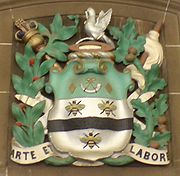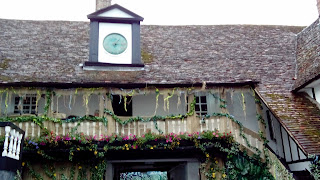While in York this past June I went back to the church of All Saints North Street, the parish church of the
Blackburn family, to photograph the windows they donated to the church. They donated two windows, the Corporal Acts of Mercy Window and the St Anne Window (also known as the Blackburn Family Window, for fairly obvious reasons). These medieval windows are among the most famous in York and provide some of the best evidence we have about the Blackburn family. From them we can work out that:
- the Blackburns were a wealthy family - very much so
- they were not averse to having this wealth displayed - probably quite the opposite
- they were probably a genuinely pious family, but they made jolly sure that this piety was of the visible kind. In this they are a typical medieval upper-middle-class citizens, practising what I call 'practical piety.'
- their favourite saints were St Anne, St Christopher and St John the Baptist
- the Blackburn women were probably literate (though this was not as uncommon as is popularly thought) and wanted this to be known
- they were important people in their local parish and in the wider city
Stained glass and practical piety
The Blackburns' motivation for donating the windows was, at least primarily, a charitable one. But, from a worldly point of view, the windows ensured that their significant wealth and their substantial largesse were on public and very visible display. From a spiritual standpoint, the Blackburns would almost certainly have viewed their donation as helping to cement them in God's good graces - an attitude that was typical of the pre-Reformation mindset. Moreover, by having themselves depicted in the windows, the Blackburns ensured that they would be remembered after death. This was not so much from worldly vanity (though no doubt that came into it too) but rather so that people looking at the windows would be reminded to pray for the repose of the Blackburns' souls. Preoccupation with purgatory and the state of the soul after death is another medieval trait.
The windows
The Corporal Acts of Mercy Window I have already written about
here. But here it is again, because the reds and blues in the glass are so pretty:
This is the St Anne Window. Currently this window forms the church's East Window, which, as it is directly behind the altar, is a church's most prominent and most important window. However, this is almost certainly not the original positioning of the window; probably it was initially in the Lady Chapel, in the north aisle of the quire. At some point it was moved to the altar, which unfortunately means that the altar candles and crucifix get in the way of a good photograph:
St Anne is in the centre light; on her left (the right as you look at the window) is St Christopher carrying the Christ Child, and on her right St John the Baptist. Directly below St Anne sits the risen Christ enthroned in glory, flanked on either side by Nicholas and Margaret Blackburn senior (to the right as you look at the window) and their son and heir Nicholas junior with his wife, also a Margaret, on the left.
Here is a better view of the saints in the three main lights:
And here are the Blackburns themselves, kneeling piously and reading diligently in the bottom corners of the window. These are the senior Blackburns; Nicholas is shown in armour, possibly a reference to his position as King's Admiral of the North. Note the shield with 'B' (for Blackburn) in the centre. The lettering along the bottom originally read 'Orate pro animabus Nicholai Blakeburn senoris quondam maioris civitatis Ebor. et Margarete uxoris eius' [Pray for the soul of Nicholas Blackburn, former mayor of the city of York, and for Margaret his wife].
And here are Nicholas and Margaret junior:
The Blackburn shield is repeated, as is the lettering along the bottom, which seems to be the same as that under the senior Blackburns except that the word senoris is replaced with junioris. The fact that both Margarets are shown reading from the Psalms (Margaret junior reads Psalm 6 [Vulgate numbeing] and Margaret senior Psalm 50) is probably intended to draw attention to their literacy as well as their piety. As mentioned above, women's literacy was not as uncommon as is sometimes thought, but did presuppose a certain level of familial wealth and prestige.
The Blackburns in Blackburn
The Blackburns were not originally a York family. They came from Lancashire, almost certainly from the area around what is now the city of Blackburn. Whether the Blackburns were named after the city or the city after the Blackburns is not clear.
On my last Sunday in England I visited Lancashire's Samlesbury Hall, and what did greet me in the Great Hall but -
 |
| The Blackburn coat of arms is the second from the right. |
- lo and behold, a Blackburn coat of arms, complete with helpful date.
I know next to nothing of heraldry (clearly a deficiency in my education :D). But some preliminary research suggests that the black wavy line through the centre of the shield represents the stream or river, known as the Black Brook or Black Water, on the banks of which the town was built. The white background possibly refers to wool or cloth; the manufacture of this was the town's chief industry and one which we know the Blackburn family to have been involved in. The stars, which apparently are correctly termed mullets, are interesting because as far as I can make out they were quite rare in the Middle Ages. Apparently they signify something along the lines of 'favoured by God' - which would fit neatly with the family's evident desire to claim, and proclaim, piety and prosperity.
Looking at the Blackburn Borough Council coat of arms I think it is possible to trace the much older Blackburn family coat of arms in the design:
The design has obviously been added to over the years, but the central elements are strikingly similar to the medieval Blackburn coat of arms: the white background, the black wavy line, and the three stars or bees - two above the line and one below. The bees apparently signify industry and perseverance; their initial letter, 'B', is also the initial letter of the town.
Heraldic sources:








